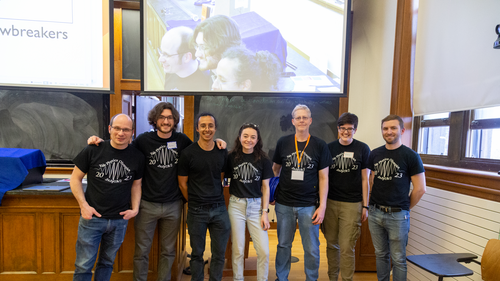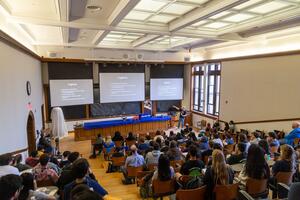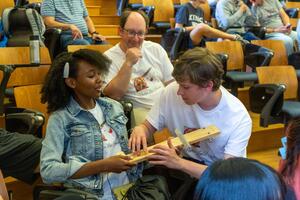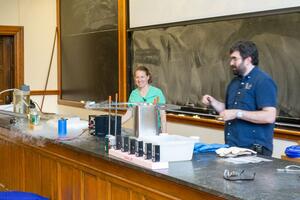
The 23rd Yale Physics Olympics (YPO) took place on April 15, 2023, at the Sloane Physics Laboratory. Fifteen teams from thirteen different schools attended, two from as far away as New Jersey.
YPO is an all-day physics competition for Connecticut and surrounding area high school students and teachers, stablished in 1998 by former Yale Physics professor Con Beausang, and is free for registered teams. Representing their high school or learning institution, students compete in teams of four to complete a pentathlon of a variety physics-themed activities. Different every year, they can involve: measuring an unknown quantity, optimizing a process, or constructing a device to perform a function. One event is always a quiz consisting of Fermi Problems, which require combining clever quantitative guesses to produce a good final estimate of some unknown number.
In addition to the five competitive events, there is a make-and-take activity for team coaches, a demonstration show (for all participants), and a talk or presentation by a Yale scientist. At the end of the day in an awards ceremony, teams are awarded first, second, and third prizes for best performance in each event. We also award first and second prizes for best overall performance and a trophy for overall best performance. There are spirit prizes too for best costume/T-shirt and best team name!
While this is a competition, it is friendly and accessible to all students. We make sure everyone has fun with physics!
 Yale Physics lecturer Stephen Irons, who organizes YPO, said “As in the past, high school physics students competed as teams of 4 in a series of 5 events to produce their best quantitative result as determined by our graduate student judges. Teams had to build a ball launcher, a boat out of terrible materials, make a box that would hold exactly 1000 glass marbles, and match a color using adjustable red, green, and blue LEDs. As always there was also a fermi quiz event that asked students to quickly estimate some interesting, if not silly quantities.
Yale Physics lecturer Stephen Irons, who organizes YPO, said “As in the past, high school physics students competed as teams of 4 in a series of 5 events to produce their best quantitative result as determined by our graduate student judges. Teams had to build a ball launcher, a boat out of terrible materials, make a box that would hold exactly 1000 glass marbles, and match a color using adjustable red, green, and blue LEDs. As always there was also a fermi quiz event that asked students to quickly estimate some interesting, if not silly quantities.  While the students were competing in their events, we also hosted a make-and-take activity for the attending team coaches. They made a two string electric guitar that came with a bluetooth voltmeter/oscilloscope that interfaces with a personal smart phone. After the teams had completed all the events, Professors da Silva Neto and Sweeney, performed a demo show, levitating superconductors, making rainbows, and accelerating a ping pong ball to a speed of over 200 m/s. After the show, we awarded prizes to 1st, 2nd, and 3rd place event winning teams, as well as custom medals to the 1st, 2nd, and 3rd overall winning schools. Eight different schools won at least a 3rd prize.
While the students were competing in their events, we also hosted a make-and-take activity for the attending team coaches. They made a two string electric guitar that came with a bluetooth voltmeter/oscilloscope that interfaces with a personal smart phone. After the teams had completed all the events, Professors da Silva Neto and Sweeney, performed a demo show, levitating superconductors, making rainbows, and accelerating a ping pong ball to a speed of over 200 m/s. After the show, we awarded prizes to 1st, 2nd, and 3rd place event winning teams, as well as custom medals to the 1st, 2nd, and 3rd overall winning schools. Eight different schools won at least a 3rd prize.  The Marvelwood School from Kent, CT won first prize overall, followed by Danbury High School from Danbury, CT in 2nd (who tied for first losing out to the Marvelwood team due to a tie breaker question), and Morris Hills School from Rockaway, NJ in 3rd. We had over 30 people, from graduate students, to faculty, to staff, and even a few children helping make this event a success. We hope and expect next year’s Olympics to be much bigger and look forward to having new members and friends of the department join us in making the YPO even more successful.”
The Marvelwood School from Kent, CT won first prize overall, followed by Danbury High School from Danbury, CT in 2nd (who tied for first losing out to the Marvelwood team due to a tie breaker question), and Morris Hills School from Rockaway, NJ in 3rd. We had over 30 people, from graduate students, to faculty, to staff, and even a few children helping make this event a success. We hope and expect next year’s Olympics to be much bigger and look forward to having new members and friends of the department join us in making the YPO even more successful.”
Long term volunteer Cindy Conforte, financial assistant in the physics department, commented, “The event ran very smoothly and it looked like everyone had a good time.” Conforte continued, “Over the years it still amazes me how well everyone comes together to make the event run smoothly and making it enjoyable for the attendees. Kudos to Stephen Irons and his team for making this event possible for the students.”
From one of our newest staff members, Donna Kennedy, senior administrative assistant in the physics department, “As a new staff member in the Physics Department, I was delighted to volunteer at the Physics Olympics. The students and teachers arrived ready to compete in the physics themed activities. It truly was a wonderful event!”
Rachel Cooper, graduate student, commented that, “I was one of the grad students running Pain in the Boat (where they had to build a boat out of terrible materials and fill it with sand until it sank). It’s always interesting to see all the different strategies that the students come up with to solve the same problem. I saw deep boats that would have held a lot of sand but weren’t stable and tipped over, big, flat boats that were stable but didn’t hold much weight, and everything in between. The creativity that the students bring to these events makes it one of my favorite events the Physics department hosts, and I’m glad to see it returning after the 3-year hiatus!”
Graduate student, Theophilus Human, who scripted the color matching event, commented that, “The color matching event was called “Watch Your Tone”. This event was inspired by James Clerk Maxwell’s 1861 demonstration of the first color photograph. Maxwell achieved this by overlaying red, green, and blue filtered images and superimposing them into a single photo of a tartan ribbon. In the challenge, students had to mix together red, green, and blue light of various intensities to reproduce a series of colors provided on a sheet. These colors were then compared with software to determine the deviation between the standard and measured color. The core challenge was using experimental creativity to eliminate sources of light pollution, alter the intensity of the light, and decide whether or not a measurement was ‘good’. A large variety of approaches were taken by various teams with some more successful than others.”
Postdoctoral Associate, Jorge Torres, commented, “I was in charge of the “Make your arc” event, in which students had to build a projectile launcher using a kit that gave them the freedom of choosing different designs for their launcher. The goal of the experiment was to build a device that would launch a ping pong ball the farthest. The challenging part of this experiment was that, while the goal was very simple, and students knew the physics behind it, they had to deal with the intricacies of designing and building an experiment in real life as a team, which is something that physicists do.”
All images are copyrighted by Pat Garcia Photographer, and credit must be given if you use them. See below for the full album.